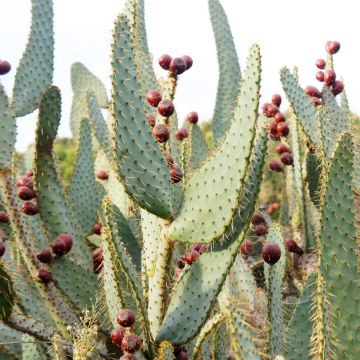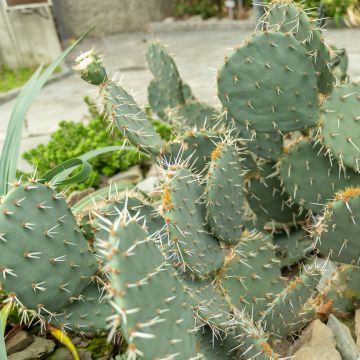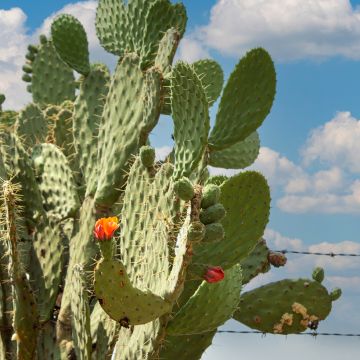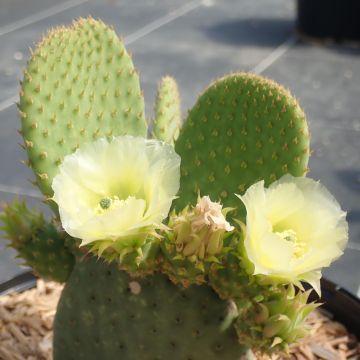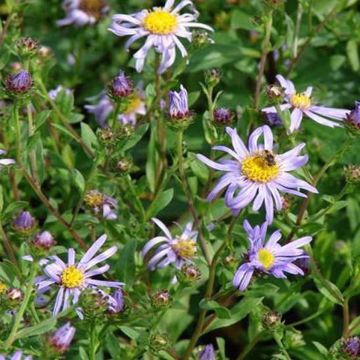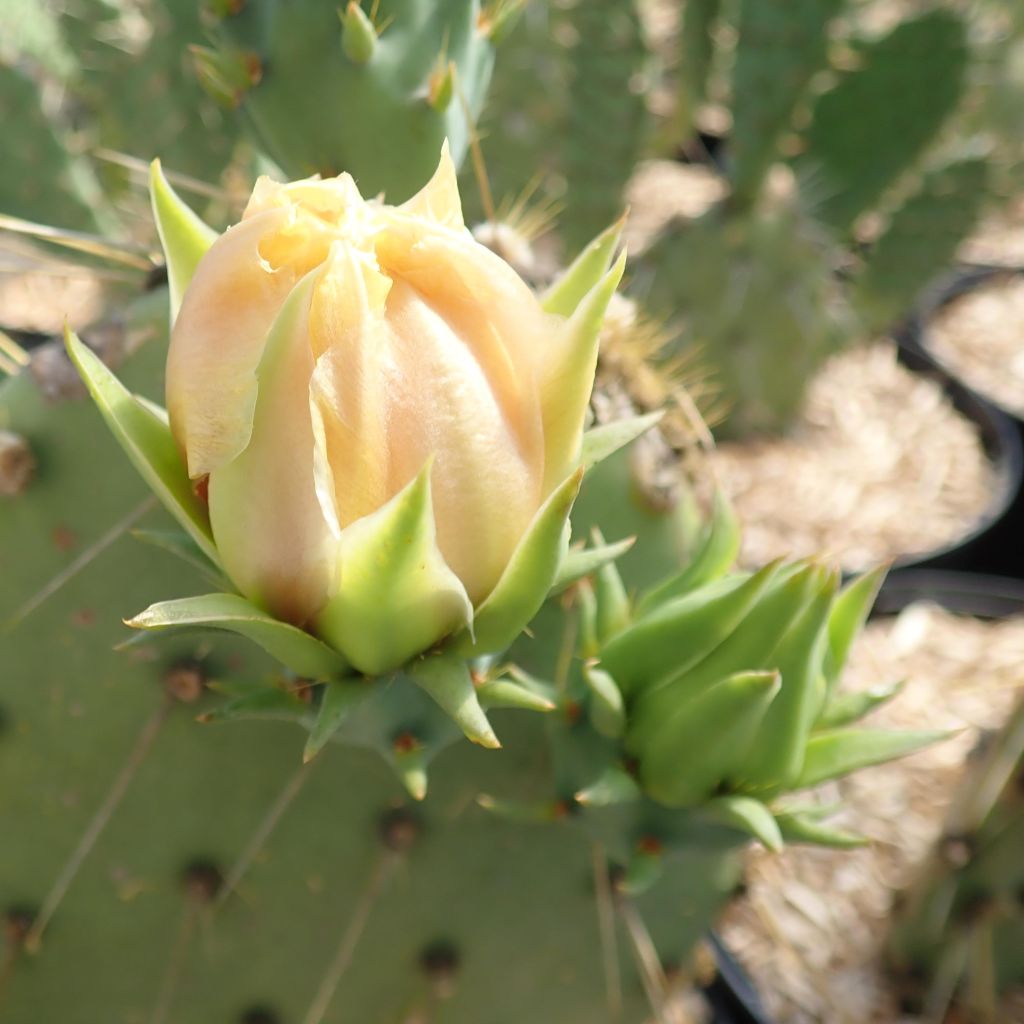

Opuntia engelmannii var. cyclodes - Prickly Pear


Opuntia engelmannii var. cyclodes - Prickly Pear
Opuntia engelmannii var. cyclodes - Prickly Pear
Opuntia engelmannii var. cyclodes
Engelmann's Prickly Pear
Why not try an alternative variety in stock?
View all →This plant carries a 12 months recovery warranty
More information
We guarantee the quality of our plants for a full growing cycle, and will replace at our expense any plant that fails to recover under normal climatic and planting conditions.
From €5.90 for pickup delivery and €6.90 for home delivery
Express home delivery from €8.90.
Does this plant fit my garden?
Set up your Plantfit profile →
Description
The Opuntia cyclodes (formerly Opuntia engelmannii var. cyclodes) is a variety of prickly pear cactus whose robust appearance is in line with its exceptional resistance to cold and snow. This plant forms a bush with a tentacle-like appearance, wider than it is tall, composed of thick and rounded "paddles" armed with long sharp yellow prickles. In late spring, they are adorned with beautiful yellow flowers, which produce edible but not very tasty round and violet fruits. Hardy prickly pears are cultivated outdoors, in open ground and away from high traffic areas, allowing them to freely express their spirit, that of the desert landscapes of North America.
The Opuntia cyclodes, a close relative of the Prickly Pear (Opuntia ficus indica), is a succulent plant devoid of true leaves from the cactus family. This botanical species is native to the arid regions of New Mexico and northern Texas. An adult specimen will reach about 90 cm (35in) in height and spread laterally for at least 1.50 m (5ft). Its growth is quite fast producing 1 or 2 new paddles per year from spring to autumn. The vegetation is composed of paddles or cladodes that are stacked on top of each other, they are flat, fleshy, thick, rounded in shape, and measure up to 20 cm (8in) long. The plant tolerates wind and the weight of snow well. The green surface of the paddles is adorned with large bright yellow prickles, which turn straw-colored over time, as well as tiny but formidable prickles called glochides, gathered in small round tufts, very dangerous when handled. Flowering occurs in June-July, earlier or later depending on the region. Several flowers appear on the periphery of the paddles, shaped like rounded cups, they are composed of petals with a fine and slightly translucent texture, lemon yellow color. They give way to small globose fruits measuring 2.5 to 3 cm (1in) in diameter, heavily covered in glochides, and ripening to a violet-purple color. While they are edible, they are less tasty than those of the Prickly Pear.
Cultivable in almost all regions, this amazing cactus is hardy down to -25°C without protection, but in perfectly well-drained, rocky, stony, or sandy soil. It naturally structures exotic or contemporary landscapes, in a large rock garden, on an arid slope, or at the edges of a dry garden. It can also be used to reinforce a defensive hedge. It will find its place among hardy agaves, Nolinas, and tree-like Euphorbias. Pair it with relatively hardy candle cacti, Cleistocactus strausii or Cylindropuntia imbricata. It should be kept away from high traffic areas and children due to its formidable spines.
Report an error about the product description
Opuntia engelmannii var. cyclodes - Prickly Pear in pictures


Flowering
Foliage
Plant habit
Botanical data
Opuntia
engelmannii var. cyclodes
Cactaceae
Engelmann's Prickly Pear
North America
Other Opuntia
Planting and care
Install Opuntia cyclodes in spring or early autumn, in full sun or even in partial shade in hot and dry climates, in a preferably poor, even rocky, chalky, sandy, but very well drained soils. It tolerates winter humidity in a porous soil, and appreciates dry, even arid soils in summer. It can withstand intense frost, up to about -23°C. Its pads sometimes collapse in winter due to the cold, but 'swell' in spring. This species tolerates snow perfectly, but also sea spray, and can therefore be cultivated in mountainous or coastal areas. It is not known ot be susceptible to pests.
Cultivation substrate: 3/4 potting soil + 1/4 vegetable soil + organic fertilizer for potted plants. Sandy, rocky soils for open ground cultivation.
Propagation is easy: take a pad at a junction, place it on a cactus-type substrate for a few days, until a callus forms. Then bury the base of the cutting a little deeper in the soil and water regularly. The plant will not flower or bear fruit before the age of 3.
Handle your cacti with gloves and protective glasses.
Planting period
Intended location
Care
This item has not been reviewed yet - be the first to leave a review about it.
Summer flowering perennials
Haven't found what you were looking for?
Hardiness is the lowest winter temperature a plant can endure without suffering serious damage or even dying. However, hardiness is affected by location (a sheltered area, such as a patio), protection (winter cover) and soil type (hardiness is improved by well-drained soil).

Photo Sharing Terms & Conditions
In order to encourage gardeners to interact and share their experiences, Promesse de fleurs offers various media enabling content to be uploaded onto its Site - in particular via the ‘Photo sharing’ module.
The User agrees to refrain from:
- Posting any content that is illegal, prejudicial, insulting, racist, inciteful to hatred, revisionist, contrary to public decency, that infringes on privacy or on the privacy rights of third parties, in particular the publicity rights of persons and goods, intellectual property rights, or the right to privacy.
- Submitting content on behalf of a third party;
- Impersonate the identity of a third party and/or publish any personal information about a third party;
In general, the User undertakes to refrain from any unethical behaviour.
All Content (in particular text, comments, files, images, photos, videos, creative works, etc.), which may be subject to property or intellectual property rights, image or other private rights, shall remain the property of the User, subject to the limited rights granted by the terms of the licence granted by Promesse de fleurs as stated below. Users are at liberty to publish or not to publish such Content on the Site, notably via the ‘Photo Sharing’ facility, and accept that this Content shall be made public and freely accessible, notably on the Internet.
Users further acknowledge, undertake to have ,and guarantee that they hold all necessary rights and permissions to publish such material on the Site, in particular with regard to the legislation in force pertaining to any privacy, property, intellectual property, image, or contractual rights, or rights of any other nature. By publishing such Content on the Site, Users acknowledge accepting full liability as publishers of the Content within the meaning of the law, and grant Promesse de fleurs, free of charge, an inclusive, worldwide licence for the said Content for the entire duration of its publication, including all reproduction, representation, up/downloading, displaying, performing, transmission, and storage rights.
Users also grant permission for their name to be linked to the Content and accept that this link may not always be made available.
By engaging in posting material, Users consent to their Content becoming automatically accessible on the Internet, in particular on other sites and/or blogs and/or web pages of the Promesse de fleurs site, including in particular social pages and the Promesse de fleurs catalogue.
Users may secure the removal of entrusted content free of charge by issuing a simple request via our contact form.
The flowering period indicated on our website applies to countries and regions located in USDA zone 8 (France, the United Kingdom, Ireland, the Netherlands, etc.)
It will vary according to where you live:
- In zones 9 to 10 (Italy, Spain, Greece, etc.), flowering will occur about 2 to 4 weeks earlier.
- In zones 6 to 7 (Germany, Poland, Slovenia, and lower mountainous regions), flowering will be delayed by 2 to 3 weeks.
- In zone 5 (Central Europe, Scandinavia), blooming will be delayed by 3 to 5 weeks.
In temperate climates, pruning of spring-flowering shrubs (forsythia, spireas, etc.) should be done just after flowering.
Pruning of summer-flowering shrubs (Indian Lilac, Perovskia, etc.) can be done in winter or spring.
In cold regions as well as with frost-sensitive plants, avoid pruning too early when severe frosts may still occur.
The planting period indicated on our website applies to countries and regions located in USDA zone 8 (France, United Kingdom, Ireland, Netherlands).
It will vary according to where you live:
- In Mediterranean zones (Marseille, Madrid, Milan, etc.), autumn and winter are the best planting periods.
- In continental zones (Strasbourg, Munich, Vienna, etc.), delay planting by 2 to 3 weeks in spring and bring it forward by 2 to 4 weeks in autumn.
- In mountainous regions (the Alps, Pyrenees, Carpathians, etc.), it is best to plant in late spring (May-June) or late summer (August-September).
The harvesting period indicated on our website applies to countries and regions in USDA zone 8 (France, England, Ireland, the Netherlands).
In colder areas (Scandinavia, Poland, Austria...) fruit and vegetable harvests are likely to be delayed by 3-4 weeks.
In warmer areas (Italy, Spain, Greece, etc.), harvesting will probably take place earlier, depending on weather conditions.
The sowing periods indicated on our website apply to countries and regions within USDA Zone 8 (France, UK, Ireland, Netherlands).
In colder areas (Scandinavia, Poland, Austria...), delay any outdoor sowing by 3-4 weeks, or sow under glass.
In warmer climes (Italy, Spain, Greece, etc.), bring outdoor sowing forward by a few weeks.


































